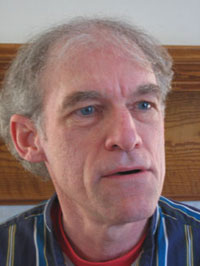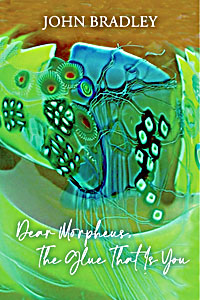|
John
Bradley
is
a
prolific
poet
of
accomplishment.
He
is
author
of
seventeen
collections
of
poetry
and
the
Steiny
Road
Poet
is
pleased
to
report
that
his
first
full-length
poetry
book
won
The
Word
Works
1989
Washington
Prize
for Love-In-Idleness: The Poetry of Roberto Zingarello and that Steiny, along with four other judges, selected it and later promoted its reissuance in a second edition.

Bradley's latest collection from Dos Madres Press is Dear Morpheus, The
Glue That Is You is a set of epistolary poems interspersed with poems that
rub against or acquiesce to the dreamscape presented in the Dear
Morpheus poems. The 2023 collection comes on the heels of the 2021
collection (also from Dos Madres) Hotel Montparnasse: Letters to César
Vallejo, which is also predominantly epistolary poems.

Steiny conducted this interview of John Bradley completed February 7,
2023.
1. Your new book Dear Morpheus, The Glue That Is You pertains to sleep
and dreams as signaled by the Greek god of sleep and dreams Morpheus.
However, your epistolary poems to Morpheus are often followed by
contradictory poems that begin with the legal term Whereas. Additionally,
you have several sections of Dear Morpheus and Whereas poems prefaced
by several sections designated as The Book of Tranquillitatus or poems
that begin with another legal term Be It So.
Could you talk about the structure of Dear Morpheus, The Glue That Is
You and why the word Glue is so important?
The poems that are directly addressed to "Dear Morpheus" are almost like
prayers, always seeking "the balm of sleep," a physical and mental and
spiritual rest from all that troubles us. Here's one such address to
Morpheus: "Because you shall dwell one day / within us, no back or chest
or brain // will itch or swell another night. / A smooth, soothed
itchlessness // shall engulf us."
But the "Whereas" poems keep reminding the petitioner of sleep of what
prevents that balm, whether it's disturbing memories (in some poems
memories of my deceased brother), or of uneasy dreams (there are
many!). Here "whereas" means "while at the same time" and "while on the
contrary." A tension, then, exists between the poems to Morpheus and the
"Whereas" poems. If forgetting or banishing the disturbing memories, say
of my brother, allow me to sleep, is that really worth the cost?
Sleep is a "glue" in that it heals, repairs, restores us. REM sleep, the deep
sleep where we dream, is a crucial part of this healing process. But what if
the dream is about entering your own home, and there's a nurse in the
bathroom tending to three bodies on stretchers? And she tells you that
your home is now hers? There's a policeman in the basement, but he
doesn't seem very concerned about the interloper. This was an actual
dream of mine and is a poem in the book.
The four sections titled "From the Book of Tranquilitatis" offer a respite
from this tension. Yet even here Morpheus appears at times, and the
dreams in these sections can feel a bit untranquil at times. In "Be It So:
You Shadow Me," one of the "Tranquilitatis" poems, for example, the
"you" in the poem could be my brother or it could be Morpheus. Or
perhaps it's both.
The book opens and closes with a sleep chant, to usher us into and out of
the world of Morpheus.
2. Something that I have been thinking about in a single author's work is
how the furniture of a particular poem is familiar. For example, John
Bradley typically populates his work with insects. In the title poem of
Love-In-Idleness, the reader meets a racing cockroach named
Love-In-Idleness. In your latest book, you ease your reader into this
community of insects in the second Dear Morpheus poem:
I breathe: allegro calmo senza rigore, which means my legs
rub together calmly yet riotously
Legs rubbing together make me think of crickets. In the third Dear
Morpheus poem, "sister found a centipede in her underpants//drawer". In
the fourth Dear Morpheus poem the narrator complains "you never
say:/My dear little bedbug".
Could you say something about your use of insects in your work—and how
often there is something endearing about these creatures?
I hadn't been aware that my poems are riddled with insects! But you are
certainly right. They do appear consistently.
I find sects fascinating, though I must admit I'm much more fond of the
cricket than the cockroach and the bedbug. There's something about
cricket song that continues to intrigue me. I've fallen asleep listening to
their arias many fall nights and feel that there's a language in their songs,
always unfathomable but there, waiting for me to decode it.
Insects are so foreign to us, almost like aliens from another planet. Yet, we
share a space with them. And they will be around, most likely, long after
humans no longer live on this planet.
3. I have noticed that unusual musical instruments show up in this book.
For example, in the second Dear Morpheus poem, there is mention of a
mouth harp, oud, cello , kazoo, and didgeridoo and on p. 49 of a Whereas
poem, we encounter the narrator confessing to burying Amelia Earhart's
goat-horn saxophone. However, there is also the human voice creating
music—on p. 63, the narrator pulls "a choir out of my femur".
How should we understand the inclusion of these music makers? Are they
just objects to lean upon (furniture) or sounds unto themselves creating
lyricism or do they stand for something else? Which brings up the question
of whether a surreal book like this uses or needs metaphor?
When I was in my twenties, I was deeply suspicious of musicality in
poetry. It felt superficial, a veneer used to steer or manipulate the reader.
Of course, this was during the Vietnam war, when even language,
especially the language used by the government and the military, felt
manipulative and deceptive. I'm thinking of terms like "body count,"
"defoliation," "friendly fire," "freefire zones," etc. At that point I wanted a
language that was stripped down to the bone.
Now I greatly admire the musicality of the human voice, which I hear in
everyday speech of those around me, as well as in poetry. I love Emily
Dickinson's rhymes and off-rhymes, Walt Whitman's King James English,
Gertrude Stein's Cubistic lingual runs, Jack Spicer's sly repetitions.
Musicality can also be heard in the rhythm of a line: "Ramon Fernandez,
tell me, if you know, " writes Wallace Stevens in "The Idea of Order at Key
West." That simple but so effective two beats and then three, followed by
two beats and then three. Lovely.
So the musical instruments are an unconscious reflection of that
appreciation of musicality.
Should surreal poems use metaphor? They should use every tool in the
toolbox, as well as the toolbox, and the arm holding the tools, and the
spider web on the shelf next to the toolbox, and the foundry that made the
tools, and the sunflower behind the foundry.
4. Which writers have influenced you?
I keep returning to Tomaz Salamun, who I have been reading for decades.
And to Wislawa Syzmborska. Her poem on a photo from 9/11, for
example, continues to intrigue me. More recently, I've been reading the
astounding prose poems of Henri Michaux. There's a great collection of
Michaux poems edited by Nin Andrews called Someone Wants to Steal My
Name. He's often called a French Surrealist, but he writes nothing like
Breton or Desnos or Mansour or any French Surrealist.
I would also have to say my local poetry group has been a steady influence
on me. I have been part of this group since I moved to DeKalb, in 1992,
meeting about once a month. While we each have very distinct and
different voices and styles, we influence each other in subtle ways. So, I
want to thank Ric and Bonnie Amesquita, Marilyn Cleland, Joe Gastiger,
Becky Parfitt, and Susan Porterfield.
I must also give credit to my dear friend George Kalamaras, who has been
reading my work for decades, and I his. We offer comments on each
other's work. He's been an incredibly good reader and a major influence
on my writing.
5. What are the differences between your surreal work like Dear
Morpheus versus Gertrude Stein's abstract work like Tender Buttons? This
can just be a general statement about what you think to be true. I know
you don't consider yourself a Stein expert.
That's a great question, one for the AI Chatbot! Let me approach this from
another angle. There's a musicality in Gertrude Stein that I love. Here's
the opening of "Susie Asado":
Sweet sweet sweet sweet sweet tea.
Susie Asado.
Sweet sweet sweet sweet sweet tea.
Susie Asado.
Susie Asado which is a told tray sure.
A lean on the shoe this means slips slips hers.
There's something surreal about this, the way Stein free associates and the
way she trusts language to open some doors: "a told tray sure."
While the surreality of Tomaz Salamun is not the same by any means,
there's a similar playfulness and inventiveness, a willingness to bend
language and logic. Here's the opening to "The Rise of the Zebra"
(translated by Salamun and Michael Thomas Taran):
The rise of the zebra hurts the zebra.
As if she would breathe fire.
If we put natural gold and the black blue into
the loaf of bread it bursts.
This excerpt isn't all that far from Stein. In fact, those last two lines sound
as if they could be in Tender Buttons.
As far as my poetry in Dear Morpheus, I don't push the associations as
much as Stein does. She's fearless! Some of the poems in the book
describe actual events, such as my brother dropping a brick on the head of
a girl who lived next door when he was a child, or his posing as a police
officer. But there are moments in some poems where the language is
Steinian: "I breathe mint, mendicant, meridian . . . ."
And I probably have encountered Susie Asado in the dream world more
than once.
So there, Dear Reader, you have a tour inside the fertile mind of John
Bradley, who speaks poetically even in an interview!
|